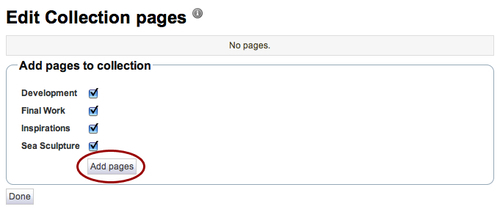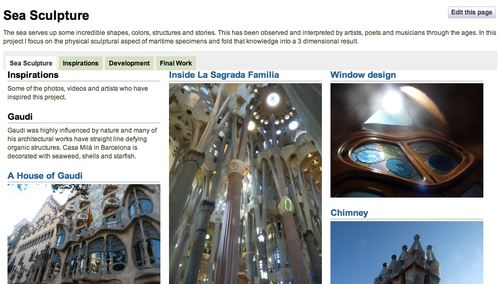Let's see how you can link some pages together to make a collection:
- Before you can get going on creating your collection, you will need to have all the pages ready to put into it. Start by creating some pages. Don't worry, they don't need to be complete and have all the content in, just to exist in your portfolio. Christophe has begun creating his pages. Here is the overview page for his collection:

- Now that you have your pages ready to add, click on Portfolio from the main menu and then Collections from the submenu.
- On the resulting page, you will see that you don't have any collections at the moment, click on Add one! or the New collection button in the top-right to start creating one.
- The next page is where you can give your collection some details. Think of a relevant collection name and give it a collection description.
- Next, decide if you would like to give your collection a page navigation bar. It is recommended that you do to start with, just to see the feature in action. When you are ready, click on Next: Edit collection pages. Here is what Christophe selected for his collection:

- On the page that you now have on your screen, you will see that you are invited to choose all the pages that you wish to add to your collection. Use the check boxes to the right of the pages to add them one at a time. You can add as many pages as you like to your collection. Christophe has selected his four pages. Then, click on Add pages:

- You will then see that all the pages you added have jumped to the top section below the Edit Collection pages title:

- You will also see that you now have some options for rearranging and removing the pages. Reorder your pages as you would like. Use the arrows on the left to rearrange the pages, the one at the top being the first and the one at the bottom being the last. Christophe wasn't happy with the order, he would like it to be Sea Sculpture, Inspirations, Development, and Final Work in order to follow a logical development progression and so reordered his pages:

- Now that you're happy with the pages in your collection, and their ordering, click on Done at the bottom to finish. You can always come back to this screen later to reorder your collection.
- When you've finished, you will see your collection appear in the collections listing along with some metadata showing you the description that you entered earlier as well as those pages that are included in the collection. Click on the title of your collection to open it up and get your first glimpse. Here is what Christophe's collection listing looks like:

You just created your very first collection of pages in Mahara. You learned how to add some information for your collection. You also saw how easy it is to add and edit the pages for your collection by pulling from those pages that already exist in your portfolio.
You chose to add a navigational bar to your collection, which for Christophe looks like this:
You may be wondering what the collection would look like if you hadn't decided to include this navigational bar. The simple answer is, the individual pages would simply act as if they didn't belong to a collection and appear exactly the same as a normal page to a viewer.
So the question is, why would you put a page into a collection and not include a navigational menu? The answer basically relates to access. As well as being a way of linking pages together using physical links, a collection also links the access permissions of all the pages it contains.
If you had decided not to include the horizontal navigation bar, you could (and probably should) choose to add a vertical navigation block instead. You will learn about the vertical navigation block later in this chapter.
If you revisit the Share section of your portfolio that you looked at earlier, you will notice that your collection has appeared there:
You can set access permissions for the whole collection in exactly the same way as you would do for an individual page as well as when adding secret URLs. Of course, you can go back and edit this access at any time.
A collection automatically inherits the access of all the pages it contains. If one of your pages in the collection is being shared only with Person A and another with Person B, the collection will be shared with both Person A and Person B.
Pages can only belong to one collection at a time.
We've just seen that when you don't allow navigation on your collection, the pages look just as they would do as normal pages. There is a way to add a different navigational menu to your collection without using the default one that runs across the top of the pages — using the Navigation block.
Try removing the top navigational menu from your collection and copying in the navigation block. You will need to put the block on every page in the collection.
Here is what Christophe's collection looks like when using the navigation block rather than the default top menu:

